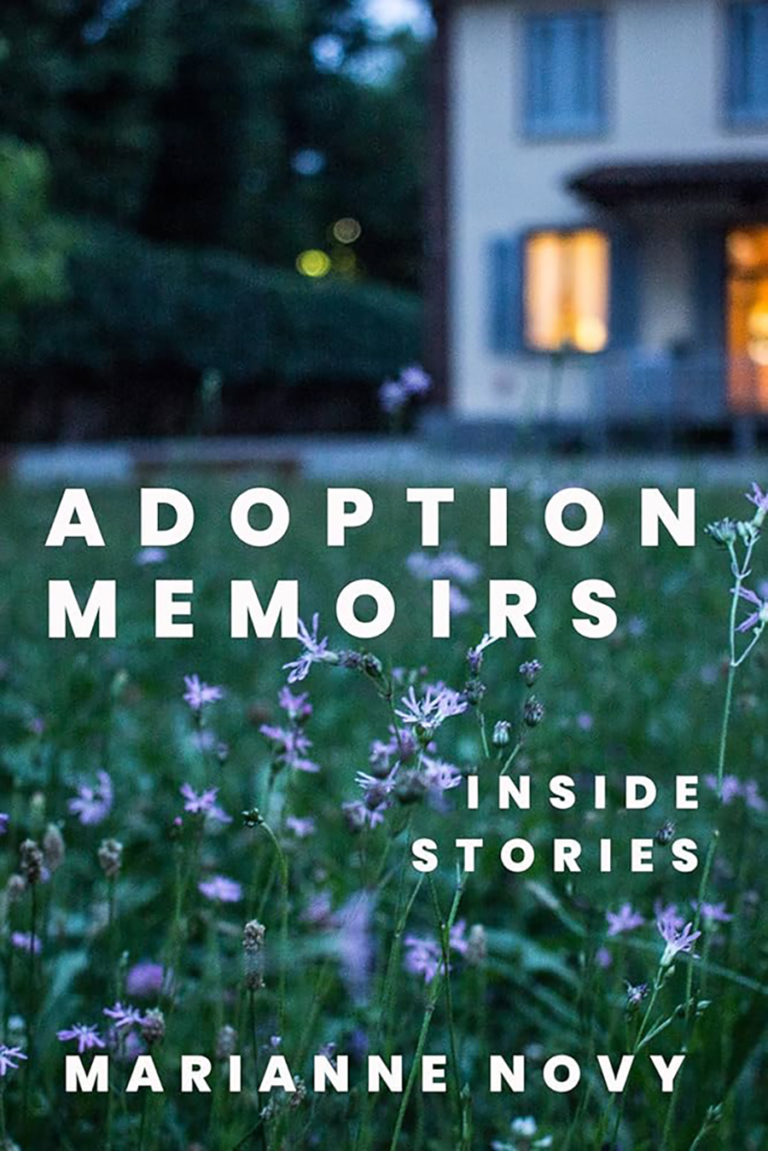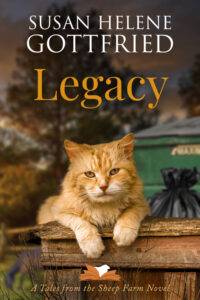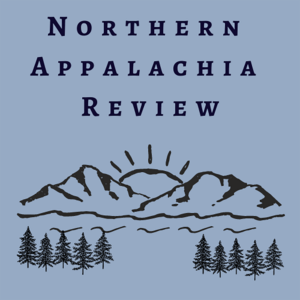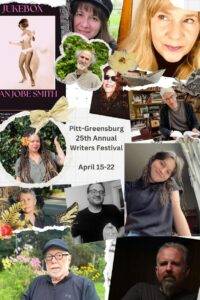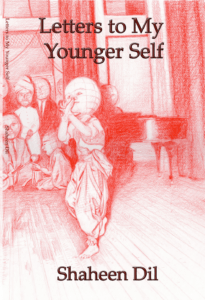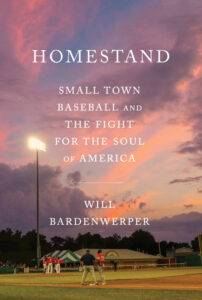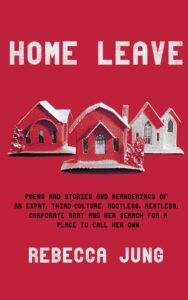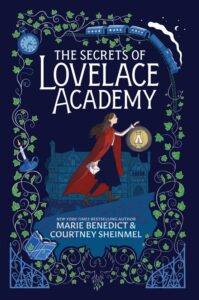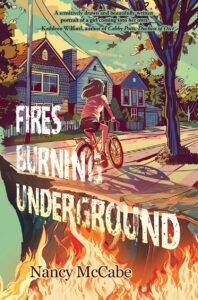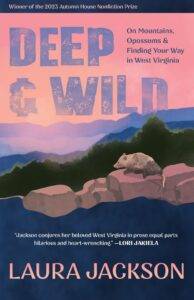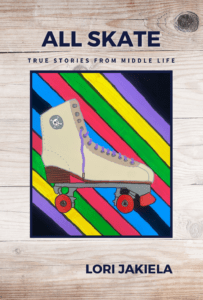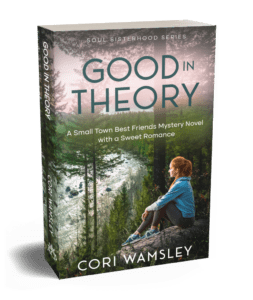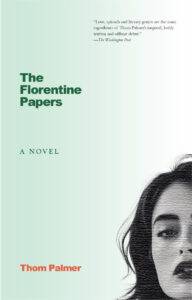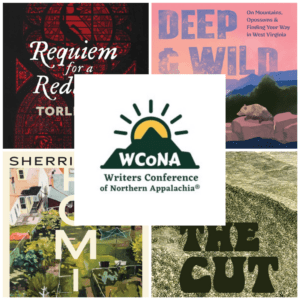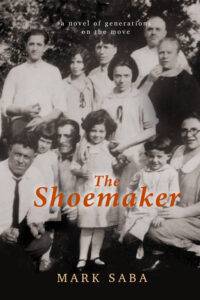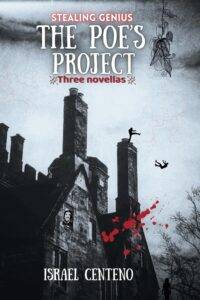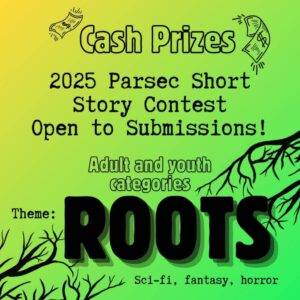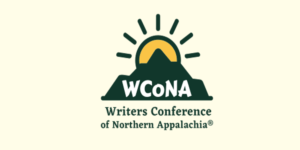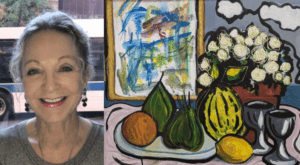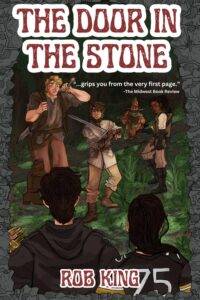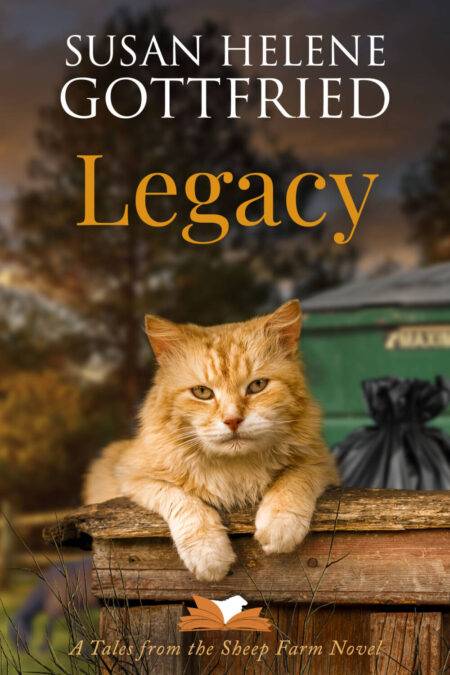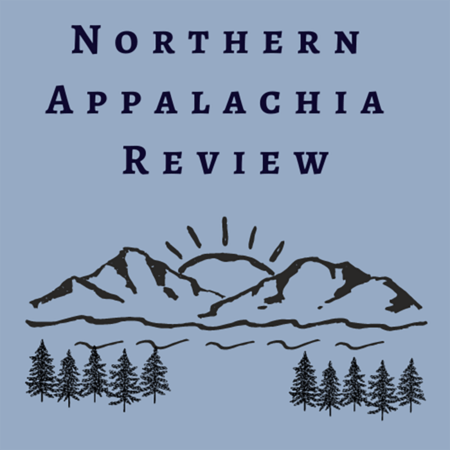“Novy’s book is a must read for anyone who researches, studies or writes about adoption.” —Lorraine Dusky, author of Hole In My Heart
From the Publisher: “Adoption Memoirs tells inside stories of adoption that popular media miss. Marianne Novy shows how adoption memoirs and films recount not only happy moments, but also the lasting pain of relinquishing a child, the racism and trauma that adoptees such as Jackie Kay and Jane Jeong Trenka experienced, and the unexpected complexities of child-rearing adoptive parents Emily Prager and Jesse Green encountered.
Novy considers 45 memoirs, mostly from the twenty-first century, by birthmothers, adoptees, and adoptive parents, about same-race and transracial adoption. These adoptees, she recounts, wanted to learn about their ancestry and appreciated adoptive parents who helped. Birthmother Amy Seek shows why open adoption is not simple, and many other memoirs tell stories that continue past reunion.
Adoption Memoirs will enlighten readers who lack experience with adoption and help those looking for a shared experience to also understand adoption from a different standpoint.”
More info About the Author: “Marianne Novy, a professor emerita, joined the English Department in 1971. She has taught Shakespeare courses on many different levels and with many different emphases as well as Renaissance in England and Early Modern Literatures in English. She developed many new courses, including Women Novelists, Contemporary American Women Writers, Women and Drama, Literature of Adoption, and Changing Families in Literature. From 1994-96 she directed the Women’s Studies Program (now the Gender, Sexuality, and Women’s Studies Program), and she served on its steering committee from the mid-seventies until her retirement. She discusses her experience with the program in a GSWS article. In November 2019 the program gave her its first Iris Marion Young Special Award for Lifetime Achievement in Social Justice.
With Ogle Duff, she developed Pitt’s Diversity Seminar, which from 1995 until 2013 helped groups of faculty use two weeks in May to make their courses more inclusive in content and dynamics. In 2000 they and later directors of the seminar received the Chancellor’s Diversity Award. She also chaired the English department¹s Pedagogy and Diversity Committee between 1996 and 2006.
Marianne has been a Trustee of the Shakespeare Association of America and a representative from both Shakespeare studies and the Middle Atlantic region at the Modern Language Association Delegate Assembly. She is also a member of the Pitt AAUP, represented the Humanities on the University Senate, and served on the Senate Tenure and Academic Freedom Committee.
Marianne has long been trying to improve the general and scholarly understanding of adoption. In 1999 she co-founded the Alliance for the Study of Adoption and Culture (ASAC)—the only organization studying adoption including the humanities—first having sessions at the MLA conventions and then, starting in 2005, its own biennial conference.
After arranging a conference of ASAC at Pitt in 2007, she started the Pittsburgh Consortium for Adoption Studies. This organization has brought together faculty and students from Pitt, CMU, Duquesne, Carlow, and elsewhere to hear speakers and see films. Some of the speakers have been Ann Fessler, showing her film A Girl Like Her about birthmothers from the end of World War 2 to the 1970s, Elizabeth Samuels, co-sponsored with the law school to discuss the sealing of adoptees’ birth certificates, and Jackie Kay and Deann Borshay Liem, portraying in poetry and film respectively what they experienced as transracial and transnational adoptees.
Most recently, together with a pediatrician, Sarah Springer, and a few visitors, she has several times taught a course on adoption and foster care to Pitt medical students.
Marianne’s most recent book is Adoption Memoirs: Inside Stories (Temple University Press, 2024), which extends the scope of her earlier Reading Adoption: Family and Difference in Fiction and Drama (University of Michigan Press, 2005).
Marianne retired in August 2016. Read an interview with her on the occasion of her retirement in The Fifth Floor.
Since retirement, Marianne has published Shakespeare and Feminist Theory (Bloomsbury/Arden, 2017); “Transcultural Adoption Literature for Pediatricians and Parents,” Adoption & Culture 6.1 (2018),135-61; “Teaching ‘Changing Families’ to Get Adoption Into the Curriculum,” Adoption & Culture 7.1 (2019), 43-66, “Memoirs and the Future of Adoption,” Adoption & Culture 9.2 (2021), 308-24; and “Class, Shame, and Identity in Memoirs about Difficult Same-Race Adoptions by Jeremy Harding and Lori Jakiela,” Genealogy 2, no. 3 (2018). Read an interview in which she discusses the development of feminist Shakespeare criticism. She has taught two Osher courses, “Shakespeare’s Outsiders: Lear and Othello” at CMU, and “Adoption: Inside Stories,” at Pitt.”
“Marianne Novy has done a masterful job of pulling on the threads of many memoirs and weaving them into a compelling narrative to make important points.” —Jana Wolff, author of Secret Thoughts of an Adoptive Mother
More info “Marianne Novy has given us a rich and powerful exploration of the deep and wide river that is adoption, separating and joining families. Her book is of value to all of us touched by adoption, and truly in some way we are all touched by adoption.” —Barbara Katz Rothman, Professor of Sociology at the City University of New York
“The word adoption has a multitude of meanings and innuendos. For many years it was seen as a fix to a problem or a way for altruistic individuals or couples to form a family. But adoption adds layer upon layer of loss for all parties, as well as trauma for the adoptee. Marianne Novy’s Adoption Memoirs is an insightful glimpse into the many realities and narratives of adoption. Do not argue with any of these stories if they are not yours. Listen. Listen. Learn.” —Dr. Joyce Maguire Pavao, Pavao Consulting and Coaching, and Lecturer in Psychiatry at Harvard Medical School
Introduction
Adoption stories often make the popular media, but features about dramatic moments such as custody transfer, reunion, or finalization of a transnational adoption don’t really tell what are the feelings at the time, let alone the long-term experience, of those immediately involved. As adoptee Nicole Chung writes in her recent memoir, All You Can Ever Know, the usual stories about adoption on TV, movies, or novels don’t show “what happened after the tears or the hugs or the accusations … the unvoiced questions, the quiet drama of the everyday.” [1] Adoption memoirs tell inside stories of adoption. At least, they tell some of what one person involved with adoption experienced over a period of time, during which they and their relationships may have changed a great deal. But this book will provide even more insight by putting contrasting inside stories together.
There is no single story of adoption, no single story for either birthmothers, adoptees, or adoptive parents. My book discusses 47 memoirs, one perhaps partially fictionalized, with the author’s real name still unknown; two of them are films rather than print. The memoirs are mostly by US authors, with three adoptees—Jackie Kay, Jeanette Winterson, and Jeremy Harding—from the UK and one—Jenny Heijun Wills—from Canada, all of whose stories resonate in some way with US readers.
As Barbara Melosh summarizes, in the US since the end of World War II, adoption has often been seen as the “best solution.” [2] Its image has been a win-win, or rather a win-win-win, with the birthmother escaping stigma and poverty, and the adopted child and parents living happily ever after together. This is the image that the Supreme Court majority relied on in Dobbs v. Jackson Women’s Health Organization, its recent revocation of Roe v. Wade, making abortion more difficult to obtain in the hope of increasing the number of adoptable children. But since the 1970s, not just melodramatic media stories but also memoirs complicate this view, as Melosh shows and this book will demonstrate in depth, revealing social justice issues in adoption.[3] From the end of World War II until 1973, more than one and a half million young women, in what journalist Gabrielle Glaser calls a “reproductive- and human-rights story,” were “funneled into an often-coercive system they could neither understand nor resist.” [4] The memoirs discussed in my book’s first chapter support her view. Though these birthmothers in important ways contrast with the woman on whom she focuses, they also do not forget relinquishment but often remember it with pain. In later chapters, we see that while some adoptees recall close and happy relationships with their adoptive parents, others do not, or find those good relationships shadowed by racism or by lack of knowledge of their origins. Adoptive parents often write that they could have used more education or more specific information to prepare them to raise their adopted children, and many adoptees agree. Getting past the secrecy imposed by closed records to meet birthparents does not in itself solve these problems. Most of these memoirs show that relationships between adoptee and birthfamily may be rewarding but can take work and sometimes turn out to be impossible to maintain.
Reading memoirs by adoptees and adoptive parents together demonstrates that some adoptive parents are still practicing the denial that many adoptees’ memoirs have been calling out for years, while others, especially concerned about adoptees’ and/or birthparents’ needs for continuity, are changing adoption practices for the better.[5] This book shows how much some adoptees appreciate parents who encourage discussions of adoption, and how frustrated others feel by parents who don’t. It provides cautionary narratives, pictures of generosity, and stories of mistakes, learning, and forgiveness. Adoption memoirs of all kinds often reveal irresponsibility, deceit, and/or cruelty by adoption agencies, social workers, orphanage directors, doctors, and, in the background, state legislators who keep birth records closed.[6] Many of these memoirs thus provide what Kimberly McKee, writing especially of those by Asian American adoptees, calls “counterstories” that “dislodge one-dimensional portrayals for multi-dimensional, nuanced realities.”[7] These memoirs show that while transracial adoption is often considered antiracist, it may expose children to overt racism and implicit bias.[8]
Adoption memoirs are also revelatory about gender issues. Not only do women predominate as authors in all genres of adoption life writing, as Barbara Melosh writes, but most of the authors who led both the movement to adopt and the movement to open closed adoption records have been women. [9] The first is mainly because women are traditionally more involved with child-rearing, the second partly because, in the US at any rate, more girls are adopted than boys, and also because, correlating with child-rearing, an interest in family relationships is psychologically more likely and culturally more expected for women, so women are more likely to search and to write about the search and its aftermath.[10] These memoirs show the persistence of prejudice against women’s and girls’ sexuality, evident in the treatment of birthmothers and occasionally of female adoptees, and not only the still predominant gendering of child-rearing as feminine, but sometimes an impossible ideal of the Good Mother. Memoirs by adoptive fathers often meditate on how different their behavior is than that of their own fathers, and many adoptive mother memoirists take it for granted that it is their responsibility to deal with their children’s emotional needs and their fault if they cannot. [11]
These are often fascinating narratives, but in addition to this they are important because people involved with adoption often feel like they cannot tell their story publicly. Some memoirists, particularly early ones and adoptees when discussing their birth family, use pseudonyms. Like some other adoptees, I was told, as a child, not to talk about being adopted, and broke that commandment only rarely even as a young adult. It may take a lot of courage to tell individual or family secrets. Yet if these are not told, stereotypes about adoption, idealizing or melodramatic, may go unchallenged and too many people may make life decisions without the help that some of these stories could give them. It is remarkable how many memoirs by adoptive parents and birth parents as well as adoptees say, in effect, “I was not prepared for how difficult my life would be.” Reading about these memoirs may provide some preparation for others.
In the 1960s, after years in which the experiences of adoptees and birthmothers were considered too secret to write about for publication, two pioneering narratives appeared. Adoptee Jean Paton published Orphan Voyage under the pseudonym of Ruthena Hill Kittson. A woman whose identity has never been discovered wrote about a birthmother’s experience in The House of Tomorrow under the pseudonym of Jean Thompson. A few books from the seventies, especially Betty Jean Lifton’s Twice Born and Lorraine Dusky’s Birthmark, helped to lift the curtain of shame. Memoirs by adoptive parents had less shame to deal with and began earlier. I mention some in the chapter on transracial adoptees, but parents’ memoirs have their own chapter. More memoirs by members of all three groups were published during and since the memoir boom, which began in the late 1980s. The earliest adoptive parent memoir I discuss in detail is Michael Dorris’s The Broken Cord, from 1989, though I brieflt discuss Helen Soss’s The Family Nobody Wanted (1954) in Chapter 3.
Few statistics on adoption are collected by the US government. The Adoption History Project website estimated, a few years ago, that there are about 5 million adoptees in the US.[12] The US population is now about 330,000,000. This would mean that around one in 66 people in the US was adopted. In 2020, according to the Children’s Bureau, there were 95,306 domestic adoptions in the US, about 19,658 of them of infants adopted privately, out of about 4 million infants born. (This is between two and twenty times the number of domestic adoptions in other developed countries, adjusted for difference in population.)[13] A fairly recent calculation is that every year in the last few decades, 0.5% of infants born in the US are relinquished for adoption, though the judges who overturned Roe v. Wade expect those numbers to be soon increased. In 2020 only 1622 children were adopted to the US from other countries; those adopted transnationally when the numbers were higher (e.g. nearly 23,000 in 2004) are now approaching adulthood and exploring especially complicated identities.[14] The US census of 2010, according to the National Center on Adoption and Permanency, estimated that 4% of families with children under 18 are adoptive families. Adoptive parents might, statistically, have a better chance of connecting than those with other relations to adoption, if they wish to.
Birthparents and same-race adoptees and adoptive parents are invisible minorities. Birthparents have significant stigma to face and so very seldom disclose their identity to others out of their family (sometimes even to others within their family, as we will see). Adoptees, whether same-race or transracial, may well grow up not knowing anyone else with that status and sometimes this in itself leads to a sense of alienation. Not only do they have a different ancestry than their parents, they may also feel different within their community. Same-race adoptees cannot identify other same-race adoptees by their appearance or by their names. If my experience is at all typical, adults rarely disclose being adopted unless they are professionally involved with the issue, are searching or are explaining their relationship with a birth relative, or commenting on a recent news item, film, or best-seller related to adoption, and sometimes not even then. It is comparatively recently that some have found communities with other adoptees, and memoirs and memoirists helped these form. Currently the internet is a large resource for such communities.
Adoptive parents of same-race children may avoid disclosing this status, though the stigma of infertility is less in the US than in the past and adoption is so often praised. On the other hand, if they want, they might find a support group, especially if they adopt through an agency. If they adopt internationally, there is almost certainly some kind of support group available, at least online, for when the children are young, and there may even be a local chapter of an organization such as Families with Children from China. But from the evidence of these memoirs, many adoptive parents do not get the support that they need.
Telling adoption stories
Adoption stories are particularly complicated to tell because every adoptee’s story is also in part the story of their parents, biological and adoptive—and every adoptive or birthparent’s story is also in part the story of an adoptee. Each person starts by seeing their own side of the story. They cannot speak their truth without telling something about how they are affected by other people’s words and actions, so they must narrate some of those other words and actions. Sometimes all they can do is speculate. Some memoirists, such as adoptee Jeremy Harding, birthmother Margaret Moorman, and adoptive father Ralph Savarese, try very hard to understand other points of view. Adoptive parents, when writing about children who are teenagers or older, may ask them to write a chapter or a shorter piece for their book.
John Raible writes of transracial adoptees’ “continual negotiation and performance of fluid racial identities over the course of a life span.”[15]Some psychologists believe that all adoptees go through phases in their attitude toward adoption.[16] However, the presence or sequence of those phases can vary enormously. Many adoptees, looking back over their lives, see their parents differently than they did in the past, and thus may guide the reader through forming an opinion and then changing it also. Following a memoirist’s change of views over time–this also includes observing birthparents and adoptive parents discovering how inaccurate their expectations have been, and/or reacting to adoptees’ changes—is one of the ways in which reading a memoir can lead to more understanding than reading an interview or the answers to a questionnaire, the tools that journalists and social scientists most often use. Each of these memoirs is the story of a many-faceted and changing individual, not reduceable to their opinions about a list of contested issues. Writing a memoir is a more public version of creating a coherent narrative of one’s life, which, as Harold Grotevant has pointed out, is the process through which adoptees, birthparents, and adoptive parents can develop an identity that incorporates adoption.[17]
In a previous book, Reading Adoption, I constructed a partial history of how adoption has been represented in literature—classical Greek drama, Shakespeare, the eighteenth and nineteenth century British novel, and twentieth century American novel and drama.[18] In its introduction I told part of my own story and located myself in relation to issues of family, identity, and others important in the dialogue around adoption. In this book I will show how many other people have so located themselves in their writing. In that book I discussed memoirs by Jean Paton and Betty Jean Lifton largely in relation to how they used Sophocles’ Oedipus. In this one I am taking memoirs more seriously.
I begin with birthmothers’ memoirs because their voices are less often heard than those of adoptees and adoptive parents, because they are more publicly stereotyped as either sluts or angels, because they can tell an earlier portion of the adoption story, that beginning with conception, than any of the others, and because they are often supposed to forget their relinquishment while memoirs show that they do not forget but instead often find the experience traumatic. Birthmothers’ memoirs challenge stereotypes, and by introducing their stories early in the book I hope also to increase readers’ understanding of some birthmothers discussed in subsequent chapters. Then I proceed to adoptees’ memoirs, since their experiences too are still less often heard than those of adoptive parents, although adoption is supposed to be for adoptees’ benefit. The experiences of same-race and transracial adoptees are different enough, though they share much also, that I give each a chapter of their own. And finally I turn to memoirs by adoptive parents. Some have clearly learned from the writings of adult adoptees, and others have not.
Adoption has changed in recent years, and this book will show some of those changes, with most of its memoirs coming from the 21st century. There are fewer children adopted now than in the 1960s, but adoption is more visible because more adoptees are transracial and/or transnational. For transnational adoptees, visiting the country of birth is becoming more common. Transracial adoptees still usually live in communities where no one else looks like them. Searching for birthparents is now more common, and DNA testing can help.[19] There are now more adoptions by gay people than in 1999 when Jesse Green published The Velveteen Father. And there are more cases of adoptions that are open not just in the sense that the adoptive parents and birth parents have met but also in the sense that they keep in contact.
How memoirs speak to each
Barbara Melosh’s chapter, “Adoption Stories: Autobiographical Narratives and the Politics of Identity,” discusses memoirs from all three relations to adoption, as I am doing, but this is unusual.[20] Since Melosh, only Margaret Homans, in The Imprint of Another Life, considers issues in all three types of memoirs.[21] As in the lives of many adoptees, birthparents, and adoptive parents, important conversations are thus left unspoken. This book will help us hear them.
Reading memoirs from several different viewpoints together is instructive. The memoirs discussed in this book often speak to each other. Several birthmothers and a few adoptive parents write about the effect on them of reading memoirs by adoptees. Many adoptive parents and adoptees agree that adoptive parents should have more education about their children’s history and about the issues they would be dealing with, especially if they are adopting transracially. Reading Black Baby White Hands, had transracial adoptee Jaiya John lived and written earlier, might have helped Douglas Bates better understand some of the behavior of his Black daughters discussed in Gift Children. Birthmothers, adoptive parents, and adoptees complain about closed state records, the failure of orphanages and agencies to give or share information, and even more unethical behavior such as allowing neglect or abuse, representing one child as another or giving children to parents who are severely depressed or whose child-rearing practices are known to be problematic. Transracial adoptees and adoptive parents sometimes discover that birthparents thought to be dead are still alive and thought that what they were signing was permission for a child to be educated elsewhere.
More strikingly, sometimes memoirs speak to each other by way of contrast. Transracial adoptee Rebecca Carroll’s Surviving the White Gaze speaks directly to birthmother Jan Waldron’s version of their story in Giving Away Simone, especially its neglect of racism. All the transracial adoptee memoirists find it important to learn about their heredity or at least their ancestral culture, and adoptive parent memoirists such as Jana Wolff, Sharon Rush, Emily Prager, Kay Trimberger, and Jeff Gammage agree. However, Green, whose sons are white but Latino, disagrees, and Theresa Reid, Claude Knobler, and Jeanne Marie Laskas at best underplay and at worst deny this importance. On a parallel issue, same-race adoptees differ among themselves, and sometimes vary at different stages of their memoir, about the relative weight of nature and nurture; so do those with other relations to adoption. Lorraine Dusky notes her daughter’s differences from her adoptive family while birthmother Janet Ellerby sees her daughter’s upbringing as similar to how she raised her other children. Adoptive father Bates is, for a while, anxious about whether his children are doomed to the disorganized behavior of their birthparents regardless of their nurture, while adoptive father Knobler believes in letting his son’s nature emerge instead of being anxious about nurturing him. Adoptive mother Trimberger, who had believed in the dominant power of nurture, revises her views as she observes her son and draws on behavioral geneticists’ analyses of interaction between nature and nurture to understand his development. But after Jaiya John’s memoir, a reader may feel that all three of these parent authors miss some of the impact of racism.
Jeanette Winterson says, in Why Be Happy When You Can Be Normal, that adoptees feel unwanted; others such as Sarah Saffian relate a very different experience. Chung, however, writes that a transracial adoptee may feel loved, may feel that in her situation “adoption was truly the best option in a sea of imperfect ones” (198) and also experience “years of wondering and confusion” (202). A few refer to the question of whether adoption in itself should be considered as traumatic, argued influentially by Nancy Verrier in her book that names separation from birthmother as The Primal Wound: but most of the adoptees whose memoirs we read, and some described by their adoptive parents, have experienced much instability, sometimes including neglect and violence, in their early years, and this, more than adoption in itself, might be the cause of feeling wounded. And, as Katarina Wegar has argued and as Lori Jakiela’s memoir especially will show, adoptees’ discomfort may often come from at least partly from stigmatization: “experiences of being adopted in a culture that defines adoptive kinship as inferior.” [22] In cases of transracial adoption, the more obvious kind of stigmatization comes from racial prejudice.
Religious language has often promoted the win-win view of adoption. Pearl Buck and Bertha Holt, who both wrote influential mid-twentieth century books promoting transnational adoption, saw it in relation to the universality of God’s love, though Buck had an ecumenical approach and Holt’s emphasis was on giving children the right religious training.[23] Catholic and evangelical Protestant cultures especially promote the view that the birthmother is doing a good deed by giving a child a secure family and a couple the child they want, rather than having an abortion.[24] We see this in the Catholic social worker Amy Seek consults. Holt’s agency is still functioning, and for many evangelicals today, discussed in Kathryn Joyce’s The Child Catchers, as for its founders, adoption is a way to deal with an orphan crisis around the world, and a chance to convert the heathen.[25] Jane Jeong Trenka’s memoir shows some of the problems with this approach.
The “win-win” view of adoption persists in secular as well as religious terms in the still influential belief that adoptees are lucky. This adjective is especially likely to be applied to transnational, transracial adoptees. Jane Jeong Trenka critiques the designation by noting all that she lost although she gained an education and some freedom, while others, such as Lori Jakiela, Jackie Kay, Chung, and Mei-ling Hopgood find luck in their particular situation—Jackie Kay and Mei-ling Hopgood because their adoptive parents are so extraordinary, and Nicole Chung and Lori Jakiela because they appreciate their adoptive parents by contrast to extremely difficult birthparents. Some adoptive parents feel that the choice of a particular child for them was fated by God or “the universe” or particularly well-chosen by the orphanage: Chung points out problems with invoking God, and the separated twins discuss the issue of fate. Religion can appear in these memoirs as a source of shame, especially for birthmothers and some adoptees, but it can also provide a connection to eloquence, rituals of inclusion, or language for gratitude.
Many adoptees’ memoirs conclude by acknowledging what they have received from both their heredity—perhaps their actual birthparents– and their adoptive parents, or from both their country of birth and the United States. However, these conclusions frequently follow troubling feelings of double identity combined with disconnection from their ancestry, especially for transracial adoptees. Transracial adoptee memoirists Trenka, John, and Catherine McKinley complain about their parents’ attempt to repress their emotions, but Kay’s and Hopgood’s parents are far from cold, and we see passionate and understanding sympathy also in adoptive parent memoirists such as Wolff, Savarese, and Prager.
Secrecy and openness
The United States formalized permanent legal adoption at an earlier date than many other countries, though many other countries have long had informal adoption practices and some, as well as some American cultures, still do. It was largely legalized state by state, with Massachusetts in 1851 passing what is considered the first modern adoption law. What makes the current US adoption system most problematic for many adoptee and birthparent memoirists is that it legally removes the birthparents’ parental role, as opposed to giving a child a greater number of caring people. Reinforcing this legal move, most states of the US (to some extent) and some Canadian provinces and other countries also separate the adoptee from his or her original parents by keeping their names and the adoptee’s name secret.
In the UK the names have been available to adult adoptees since 1975. The memoirs of UK adoptees Jackie Kay, Jeremy Harding, and Jeanette Winterson, all authors widely known in the US, reflect this difference, though much of their family and search dynamics have partial parallels here. Many adoptees find the search process frustrating because of closed records. For Harding, as well as for Jean Strauss and A.M. Homes, going through records that are public eventually gives a feeling of inclusion in larger histories. With the extensive current interest in genealogy and genetics, they share their quest with many others.
As adoption historian Wayne Carp and legal scholar Elizabeth Samuels have shown, in a significant portion of the twentieth century the names were supposed to be available to an adoptee who had reached adulthood.[26] Over the past few decades, after much political advocacy, some states have returned to that level of availability, but some only for those born after a certain date, or not prohibited from knowledge by a veto from their birthmother. And some adoptees have made contact through DNA analysis or social media.
On the other hand, many adoptions today do involve early contact between the adoptive parents and the potential birthparents, and sometimes this contact continues and includes the child, as in Wolff’s memoir Secret Thoughts of an Adoptive Mother and Amy Seek’s God and Jetfire, or resumes before adulthood, as in Carroll’s Surviving the White Gaze and Waldron’s Giving Away Simone. The openness always intended by Wolff and Seek, from their different perspectives, is probably in part a consequence of adoptees speaking out about the positive impact of meeting their birthparents as adults by contrast to their years of wondering. All four memoirs, however, show that an open adoption, even in the best of circumstances, which Seek has, is still emotionally challenging. Like some memoirs which continue after reunion, they reveal that it is often hard for birthmothers and adoptive mothers to avoid feeling that they are in competition. Furthermore, unlike most adoptee memoirists, Carroll feels that the relationship with her birthmother made her life worse.
Memoirs’ variations and goals
This book is about memoirs and not about therapy or statistics. People who write memoirs are not necessarily representative of their demographic group. But they may have insights about experiences they share with many others. Research on birthmothers shows that, rather than the forgetting they have been promised, many have feelings of loss similar to those of our memoirists. Some adoptees who write may be like canaries in a coal mine, revealing problems that others have covered up or narrowly escaped. So might some adoptive parents, since they too can suffer from the irresponsibility of adoption agencies.
Still, in this book I discuss many memoirs in each category to emphasize that adoption experiences vary enormously and suggest reasons for some variations. For example, some adoptive parents who write memoirs want contact with birthparents, some do not because of what they know about how their child was treated, some without such knowledge think contact would be threatening to their sense of full parenthood. Every birthmother who writes a memoir wants contact with her child, but some adoptee memoirists find that their birthmother does not. Or one or both find the relationship too difficult. Nicole Chung, for example, discovers that her birthmother was abusive to her sister. In most of the chapters, I make the point about variations by comparing several memoirs in each of several categories, though the experiences and conclusions of birthmother memoirists have more similarities than the others. That chapter is shorter largely because fewer birthmothers have published memoirs.[27] No American birthfather, and only one from the UK, has published a memoir about relinquishment, although some birthfathers may have published memoirs that do not mention a child biologically theirs they did not raise.[28]
More than most memoirs, perhaps, adoption memoirs from all perspectives often have as their intended audience people who are or might be in a situation similar to those of the memoirist, or might be dealing with others in that situation. Readers might be asking themselves, “Should I adopt?” or “What will it be like if I have my child adopted?” or “Should I try to meet my birthparents?” or “Why does my child want to meet her birthparents, and how would that affect our relationship?” A few memoirists in each category are explicit about addressing such a reader. This group includes adoptive parents Knobler, Reid, Wolff, Trimberger, and David Marin, but also birthmothers Dusky and Moorman and adoptee Kay. Many of these books would also be helpful to a reader asking, “What should I do about the difficulties my adopted child is having?” Or “Should I try an open adoption?” Or “Why is my birthparent (or my birthchild) finding our relationship difficult?”
But trying to help individual readers is not the only stance that the memoirists in this book take. Thomas Couser discusses the connection of memoirs with civil rights movements.[29] Adoptee memoirs in the United States, especially, may allude to and contribute to the movement for open records, birthmother memoirs to that and also to a movement of their own for better treatment, memoirs of transracial adoptees to anti-racism movements, Green’s, among those I discuss here, to the movement for gay civil rights; Savarese’s, especially, to the disability rights movement, though the memoirs of Michael Dorris and Ann Loux are relevant to it also.
Some adoptee memoirs, such as those by McKinley, Hopgood, and John, are variants on the coming-of-age plot. Couser sees the portrayal of unhappy childhoods as “survivor testimony” (148) but memoirs by adoptees of childhood unhappiness are very often also attempts to educate prospective adoptive parents about how to raise their children better, expressing sympathy for their own parents who did the best they could, not having enough preparation. They might fall in his category of filial narratives, analyzing adoptive parents or birthparents or both (154). A few, especially those by Kay and Hopgood, are part tributes to their adoptive parents. But memoirs from all positions in relation to adoption are also attempts to make sense of its role in their own lives.[30]
When Melosh wrote her summary of adoption memoirs, the memoir boom was underway, and the number of memoirs published and read has continued to grow since then. As Couser writes, this is a genre very close to the storytelling that everyone does in the course of their lives (26), and therefore widely accessible to both readers and writers. I hope that my inclusion of many recent memoirs will help expand people’s awareness of the range of adoption experience. It is worth noting that even with this boom some important memoirs still have to be self-published. It is not a coincidence that memoirs by a pioneering adoptee (Jean Paton), a militant first mother (Dusky prefers this term) and two Black men, Jaiya John and Craig Hickman (the latter further minoritized by being gay) fall into this category. I also want to expand the canon to include memoirs of adoption from one white family to another, in which the main issue is class, not race—those by Harding and Jakiela. Perhaps I find these books particularly moving not only because of being in a white same-race adoption myself but also because I, like these memoirists and unlike most I discuss, am writing after the death of my adoptive parents and identify with that aspect of their explorations.
However, transracial adoption memoirs are especially compelling partly because through the lens of a single family, they dramatize the racial divisions of our world. My previous adoption writing emphasized the themes of adoptee search and reunion, but reading transracial adoption memoirs has illuminated for me the injuries of childhood experiences of bias and bigotry. Reading them has made me realize again how fortunate I have been to escape dealing with racial prejudice against me. While I was uncomfortable that my adoption was a secret, many adoptees are uncomfortable that their adoption is all too visible. Regardless of our relative visibility, all adoptees share experiences of loss and of being in a non-normative family, and many of us have shared the experience of parents finding adoption a difficult topic to talk about and of complications in relationships with recovered birth family members. And while reading memoirs by adoptive parents and birthmothers, I have also had moments of identification with them from my own experience of parenthood, moments when I felt that I was learning from them more of what parenthood was about.
These memoirs showed me again what Elaine Scarry calls “the capacity of literature to exercise and reinforce our recognition that there are other points of view in the world, and to make this recognition a powerful mental habit.” [31] Given the isolation that many adoptees and birthparents and adoptive parents feel, I would like this book to promote a sorely needed dialogue among our different perspectives, as well as helping others to understand and benefit from the viewpoints and experiences of the memoirists discussed here. As I showed in Reading Adoption, fiction about adoption has often presented either the adoptive parents or the birthparents as uniquely important, though when analyzed in depth the treatment may be more complex. In this book I find that most adoptees’ memoirs show both sets of parents as important.
Language
A few words about language issues. For centuries the tradition was to use “natural” to refer to children born out of wedlock and their parents. “Real” and “true” have also sometimes been used to refer to the parents who bore and begot children. But many adoptees and adoptive parents object to this usage, and many dictionaries also define “mother” in relation to ongoing care rather than to childbirth. A few memoirists treated here, most notably Harding, still use “natural” ; this usage may have continued longer in England.
In 1976, Lee Campbell was the first person to use the one word “birthmother,” on the model of grandmother and godmother, to identify herself as she was trying to organize a group she called Concerned United Birthparents.[32] Many women who have surrendered children have followed her in calling themselves birthmothers, and so have many social workers and adoption agencies, though they often write it as two words instead of one. However, some believe that term denies a woman’s continuing concern for the child, and prefer “first mother” or “original mother.” These words are factually accurate and I use them occasionally, but I believe the use of the word by early activists Lee Campbell and Carole Anderson refutes the objection to “birthmother”. Furthermore, as “adoptive mother” does not imply that a woman’s concern for a child ends with the finalization of adoption, so “birthmother” does not imply that it ends at birth. I prefer the one-word form to the two-word, because this is what Lee Campbell used. Much of the time I use the term that the memoirist is using. Often it is just “mother” and it is clear from the context which way the relationship began. I also write “birthfather” and “birthparent” as one word each, since Campbell did. The analogy with godfather and grandfather, etc., works for them, and they describe relationships more basic than those of other family members; however , in direct quotations I follow the authors’ usage.
And about the name of the memoirist as writer and character in their book. In the first and fourth chapters I refer to the memoirist as writer and as character by the same name. With the adoptee memoirists, when discussing them as children and young people in their memoirs I sometimes refer to them with the first name they had at the time. If this leads to some inconsistency, that may reflect the sense of multiple identity many adoptees experience.
My own story
Let me locate myself briefly before the detailed treatment of other life stories begins. In some ways my experience was like those of many other adoptees at the time, though better than some, beginning with my birthmother’s month with me before I was moved to my adoptive home. My new parents didn’t have much, if any, counseling—it was 1945. They presented it positively—they had chosen me, they would be able to take better care of me. But they didn’t know not to tell me I shouldn’t talk about adoption because other people wouldn’t understand.
Like adoptive parents discussed by some memoirists in this book, they were not carefully vetted. My adoptive father may have already been on his way to the alcoholism that killed him at 57. But he was or had been the partner of the doctor who looked after the pregnant women in Cleveland’s Florence Crittenden Home. He knew, I found in a thank-you letter that man’s daughter had saved, that he did not know how to be a father, and no one helped him. On the other hand, my adoptive mother was warm, affectionate, open-minded, and education-oriented although—or rather because—she herself had left school around 14 for work to help her family, returning in her 50s. A more than good-enough mother.
Timid and in a conservative framework though she was, nevertheless my birthmother welcomed meeting me, introduced me to the seven sons born after her marriage, two of them still in high school, and encouraged me to visit again across the miles of four states. She got to the point where she would tell our story to a salesperson if I took her out to buy shoes. It was not an easy relationship for a while since we were very different, but we worked at it because it was important to both of us.
My birthfather didn’t want contact with me at that time or later, but I will be forever grateful to him for sending me, without comment, a newspaper article about him with his picture. He was the one I looked like. He had a successful life and professional partnership with the woman he married a few years after he returned from the war in Europe. I eventually found her self-published late in life memoir while googling, and discovered the names of their children. Thus I was able to learn when he had died and then discreetly contact their son, in time to meet him before the pandemic.
My birthparents met across the Jewish-Christian divide during World War II, she a naïve WAVE (member of Women Accepted for Volunteer Emergency Service) at 26, he a streetwise 18-year-old who joined the army after his mother died, both away from their respective homes in small-town Wisconsin and Brooklyn. From what I know, they could never have been happy together, as each of them seems to have been in their marriages. They became pillars of their disparate communities. Possibly I was placed with an interfaith Protestant/Catholic couple partly because I was conceived in another kind of interfaith match and would not have fit with most agencies.
My experiences have led me to warm feelings for both adoptive mothers and birthmothers. Also, I remember, from years before my marriage, the time when getting pregnant seemed like a disaster to avoid, and from a few years after my marriage, before infertility treatments worked, the time when we started investigating adoption for ourselves (before I started seriously researching it beyond search issues).
Finding and contacting the early adoptee memoirists made a big difference to me. Jean Paton and Betty Jean Lifton both gave me guidance in my search for ancestry and later for the literary history of adoption, in person as well as in their books and letters. In reading their memoirs and the later ones in this book, I felt like I was discovering still another family, brave heroes who persisted against difficulties much greater than mine. The birthmother and adoptive parent memoirists helped me understand some of what my own mothers faced, and more about other dimensions of parenting. In these memoirs I have found moving portrayals of grief, anger, courage, persistence, joy, learning, and forgiveness. I hope my account of them will help readers understand the complexity of emotions that people may feel in their involvement with adoption, and see the complexity of the justice issues adoption can pose. And I hope that my readers will seek out these memoirs, to live through their whole stories and to consider how adoption policies and practices might be changed for the better.
[1] Nicole Chung, All You Can Ever Know (New York: Catapult, 2018), 74.
[2] Barbara Melosh, Strangers and Kin: The American Way of Adoption (Cambridge, Mass: Harvard University Press, 2002), 105-06.
[3] One article that gives a larger social context to its critique of media treatments of adoption is Danae Clark’s “Mediadoption: Children, Commodification and the Spectacle of Disruption,” American Studies Vol. 39, No. 2 (Summer 1998); 65-86.
[4] Gabrielle Glaser, American Baby: A Mother, a Child, and the Shadow History of Adoption (New York: Viking, 2021), 6. The number comes from P. L. Maza, “Adoption Trends: 1944-1975,” in The Adoption History Project website. Glaser, 118, refers to this system as the “adoption-industrial complex,” making more general Kimberly McKee’s term “transnational adoption industrial complex,” introduced in Disrupting Kinship: Transnational Politics of Korean Adoption in the United States (Urbana: University of Illinois Press, 2019), 2).
[5] Cf. H. David Kirk, Shared Fate (1963: second edition, Port Angeles, WA: Ben Simon, 1984), which shows that adoptive parents who acknowledge the difference of their family have better communication with their children than adoptive parents who reject the idea that their families are different.
[6] Glaser, 100, reveals even more ethical violations in the Louise Wise adoption agency, where babies who had no legal parents to protest were tested to see their reactions to pain.
[7] McKee, Disrupting Kinship, 81.
[8] Many social workers also agree that parents who adopt transracially, especially, need a better understanding of how racial issues affect their child. See Elizabeth Raleigh, Selling Transracial Adoption: Families, Markets, and the Color Line (Philadelphia: Temple University Press, 2018), esp. 187-201.
[9] Melosh, Barbara. “Adoption Stories: Autobiographical Narratives and the Politics of Identity,” In Adoption in America: Historical Perspectives, ed. E. Wayne Carp, U of Michigan 2002, 221-22; Soojin Chung, Adopting for GodThe Mission to Change America through Transnational Adoption. New York: NYU Press, 2019, 138, contextualizing Helen Doss’s The Family Nobody Wanted (1954).
[10] On statistics and possible explanations, see John Gravois, “Bringing Up Babes: Why Do Adoptive Parents Prefer Girls,” Slate, Jan. 14, 2004, consulted July 6, 2022); Barbara Melosh, Strangers and Kin, 54-68, similarly suggests that prospective parents believe girls are more malleable and affectionate. For analysis that might explain further why women led and lead the movement to open adoption records and why many write memoirs about their search and aftermath, see Susan Stanford Friedman, “Women’s Autobiographical Selves: Theory and Practice,” in Women, Autobiography, Theory: A Reader, ed. Sidonie Smith & Julia Watson (Wisconsin, 1998), 72-82.
[11] See Adoption and Mothering, ed. Frances J. Latchford (Bradford, Ontario: Demeter Press, 2012).
[12] The Adoption History Project website, https://pages.uoregon.edu/adoption/ was last updated in 2012. In 1980, according to Glaser, 204, the estimate was “over 5 million living.” The CDC’s most recent National Survey of Adoptive Parents, from 2007, estimated 1.8 million adopted children under 18, excluding stepchildren.
[13] Gretchen Sisson, Relinquished: The Politics of Adoption and the Privilege of American Motherhood (New York: St. Martin’s, 2024), 31. Upon my request, Professor Sisson generously gave me access to her book before publication.
[14] Sisson, Relinquished 26.
[15] John Raible, “Life-Long Impact, Enduring Need” in Outsiders Within, ed. Jane Jeong Trenka, Julia Chinyere Oparah and Sun Yung Shin (Cambridge, Mass. South End Press, 2006), 181.
[16] J. Penny, et al., “Reconstruction of adoption issues: Delineation of five phases among adult adoptees,” Journal of Counseling & Development, 85, iss. 1 (2007) 30-41, summarized in Child Welfare Information Gateway, “Impact of Adoption on Adopted Persons,” August 2013, 4-5. See also David Brodzinsky, et al, Being Adopted (New York: Doubleday Anchor, 1993), on variability among adoptees and across their life span.
[17] H. D. Grotevant, “Coming to Terms with Adoption,” Adoption Quarterly 1 (1997), 3-17. Of course, there are some memoirists, such as Jane Jeong Trenka, who intentionally, for much of their memoir, stress that adoption has made their life incoherent.
[18] Reading Adoption: Family and Difference in Fiction and Drama (Ann Arbor: University of Michigan Press, 2005).
[19] This occurs in Glaser, and in Dani Shapiro’s memoir Inheritance (Knopf, 2019), though there the issue is unacknowledged sperm donation. See Richard Hill, “How DNA Testing is Changing the World for Adoptees,” in Adoption Reunion in the Social Media Age, ed. Laura Dennis (Redondo Beach, California: Entourage, 2014), 80-88.
[20] Barbara Melosh, “Adoption Stories,” 218-45; Emily Hipchen and Jill Deans discuss only adoptee memoirs in “Introduction: Adoption Life Writing: Origins and Other Ghosts,” a/b: Auto/Biography Studies 18 (2003):163-70; Sidonie Smith and Julia Watson, Reading Autobiography: A Guide for Interpreting Life Narratives, also have a brief discussion of birthmothers’ memoirs, even more briefly include the phrase “adoptive parent (s),” and place gay adoptive fathers under the category of “filiation narrative”, 255 and 270.
[21] Margaret Homans, The Imprint of Another Life: Adoption Narratives and Human Possibility (Michigan, 2013). Three anthropologists make parallel attempts. Linda Seligmann, Broken Links, Enduring Ties: American Adoption Across Race, Class, and Nation (Stanford, 2013), draws on some memoirs and other writings by adoptees, in addition to interviewing adoptive parents and their children, and so does Barbara Yngvesson, Belonging in an Adopted World: Race, Identity, and Transnational Adoption (Chicago 2010). Before most of the memoirs discussed here were published, Judith Modell interviewed people with all three relations to adoption, including me, and consulted adoption memoirs by Lifton and Paton, for her book Kinship with Strangers: Adoption and Interpretations of Kinship in American Culture (Berkeley: U of California P), 1994. Her book does not deal with issues of racial or national difference in adoption, which were mostly less discussed when it was researched.
[22] Katarina Wegar, Adoption, Identity and Kinship The Debate Over Sealed Birth Records. (New Haven: Yale University Press, 1997), 131.
[23] Soojin Chung, Adopting for God, 57-118.
[24] However, evangelical opposition to abortion was not absolute when Holt wrote, or in the 1960s and early 1970s, according to Frances FitzGerald, The Evangelicals: The Struggle to Shape America (New York: Simon & Schuster, 253-550.
[25] Kathryn Joyce, The Child Catchers: Rescue, Trafficking, and the New Gospel of Adoption (New York: Public Affairs, 2013).
[26] E. Wayne Carp, Family Matters: Secrecy and Disclosure in the History of Adoption. Harvard UP, 1998; Elizabeth J. Samuels, “The Idea of Adoption: An Inquiry into the History of Adult Adoptee Access to Birth Records,” Rutgers Law Review, Vol. 53, No. 2 (Winter 2001), 367-436.
[27] Margaret Homans discusses two more, Karen Salyer McElmurray’s Surrendered Child A Birth Mother’s Journey(Athens: 2004), and Meredith Hall, Without a Map (Beacon, 2007). Barbara Melosh’s chapter discusses aspects of 38 memoirs from all 3 positions published before 1999. She observes that adoptive parents have published the most and birthmothers the least (apart from birthfathers). I have decided not to discuss some memoirs in which adoptive parents end the story before children leave infancy and some in which adoptees focus on their career with little emphasis on search or relationships. I have limited the number of memoirs that emphasize parental cruelty or irresponsibility.
[28] Andrew Ward, The Birth Father’s Tale (London: British Association for Adoption and Fostering), 2012. Mary Martin Mason collected interviews in Out of the Shadows: Birthfathers’ Stories (Edina, MN: O. J. Howard,1995).
[29] G. Thomas Couser, Memoir: An Introduction (New York: Oxford University Press, 2012), 149-50.
[30] Laura Briggs, “Making ‘American’ Families: Transnational Adoption and US Latin American Policy,” in Haunted by Empire: Geographies of Intimacy in North American History, ed. Ann Laura Stoler (Duke, 2006), 346; Grotevant, quoted in n. 17 above.
[31] Elaine Scarry, “Poetry, Injury, and the Ethics of Reading,” in The Humanities and Public Life, ed. by Peter Brooks with Hilary Jewett (Fordham UP, 2014), 42, explains the argument of Pinker in The Better Angels of Our Nature, with which she agrees, that the novel is in part responsible for the humanitarian reforms of the eighteenth and nineteenth centuries.
[32] Adoptive mother Pearl Buck used “birth mother” in “I am the Better Woman for Having My Two Black Children,” Today’s Health, 50 (Jan.1972): 21, quoted in Richard Uhrlaub and Nikki McCaslin, “Culture, Law and Language: Adversarial Motherhood in Adoption,” in Latchford, Adoption and Mothering, 200.
This excerpt has been published here courtesy of the author and should not be reprinted without permission.


